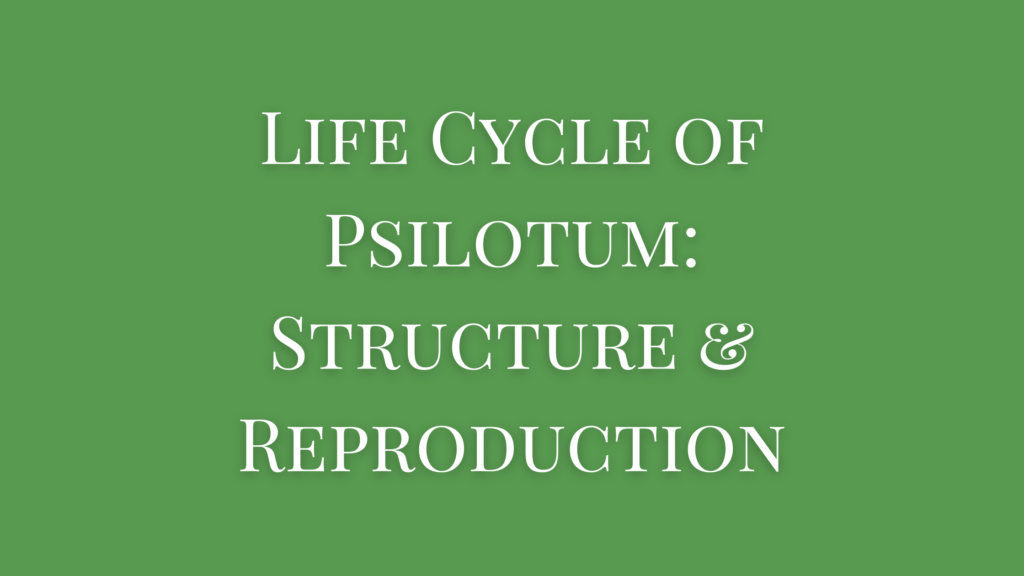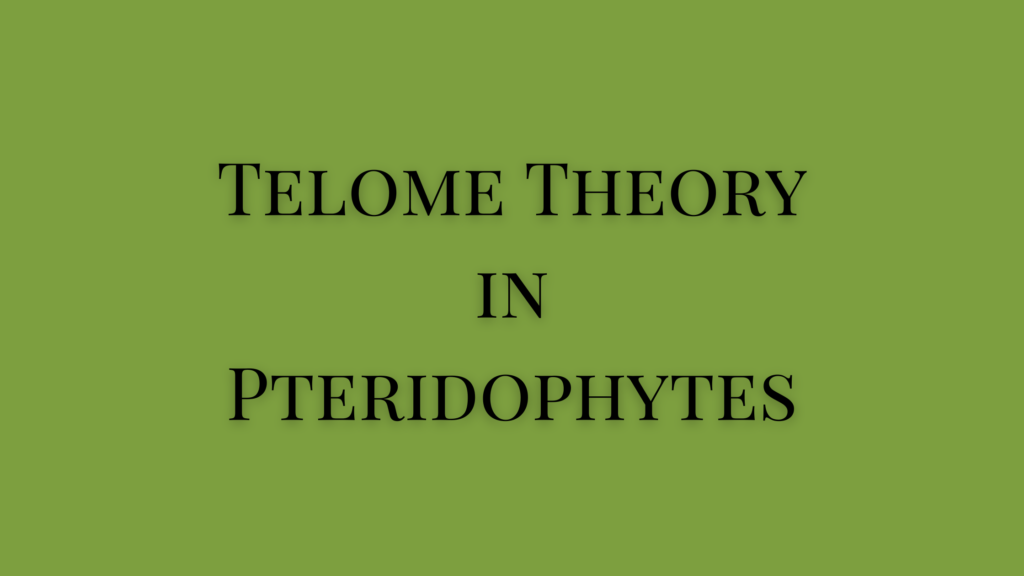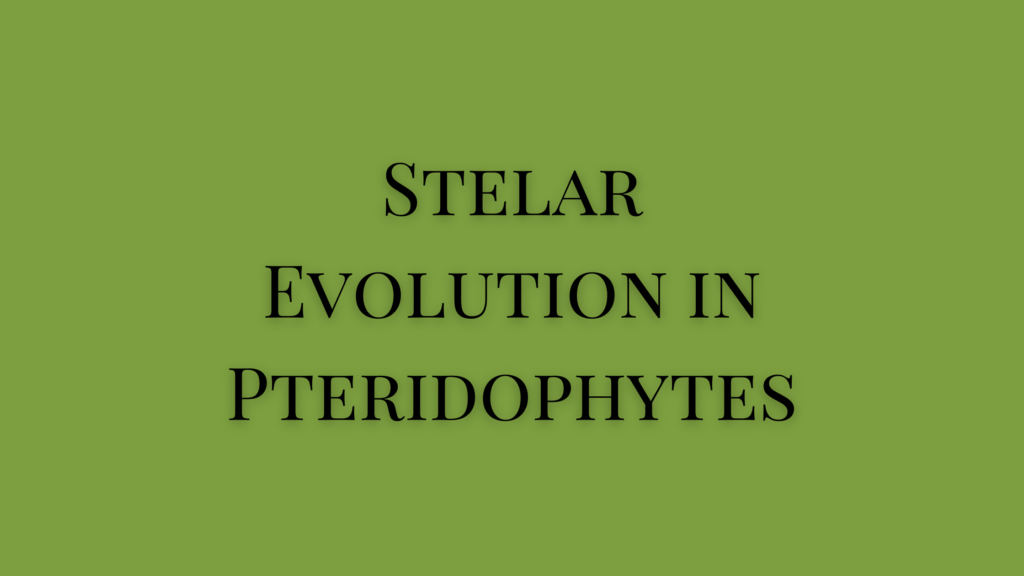Psilotum is an epiphytic pteridophyte seen on the base of dead and decaying tree trunks as well as on rock crevices. Psilotum flaccidum is an example of a hanging epiphyte. Under favorable conditions, its thallus can grow up to a height of 25 inches.
The life cycle of Psilotum alternates between the diploid and haploid generations formed by the sporophyte and gametophyte respectively. Here, we will discuss the structure, reproduction, and life cycle of Psilotum.
Morphology of Psilotum
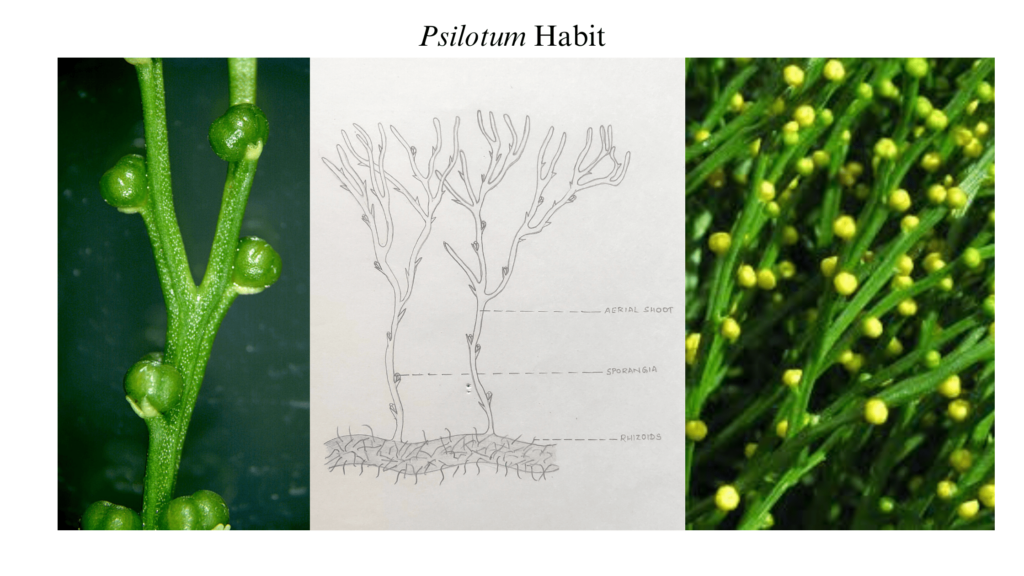
- The plant body of Psilotum is differentiated into an upper and lower body. It has an underground rhizome just inside the soil.
- It shows dichotomous branching and a large number of filamentous rhizoids.
- Rhizoids are 2-3 cells long with a cuticle over it.
- They help the rhizome fix in the soil and also absorb nutrients and water.
- The erect ariel branches arise from the rhizome.
- The shoots are branched in Psilotum nudum and pendant-like in P.flaccidum.
- Shoots show dichotomous branching, appear green, and slender with ribbed texture.
- The axis is angular at the base and cylindrical at the top.
- Leaves are scale-like, riding from the stem and arranged spirally.
- Leaves are non-photosynthetic and devoid of vascular bundles.
- It is the stem that performs photosynthesis.
Internal Structure of Psilotum
Rhizome Anatomy
- A cross-section of the rhizome shows a circular outline, with a lining of single-layered epidermis.
- A cuticular layer is present outside the epidermis and over some rhizoids.
- The rhizoids arise from the elongated epidermal cells.
- The cortex of Psilotum is differentiated into the outer, middle, and inner cortex.
- The outer area of the cortex is made of thin-walled parenchyma cells. These cells contain mycorrhizae.
- The parenchymatous cells in the middle cortex store starch grains.
- The inner cortex is made of thin-walled, brown-colored parenchyma cells.
- These cells contain phlobaphene, an oxidation product of tannin.
- The innermost layer of the cortex is the endodermis with Casparian thickening.
- Endodermis is followed by a single-layered pericycle.
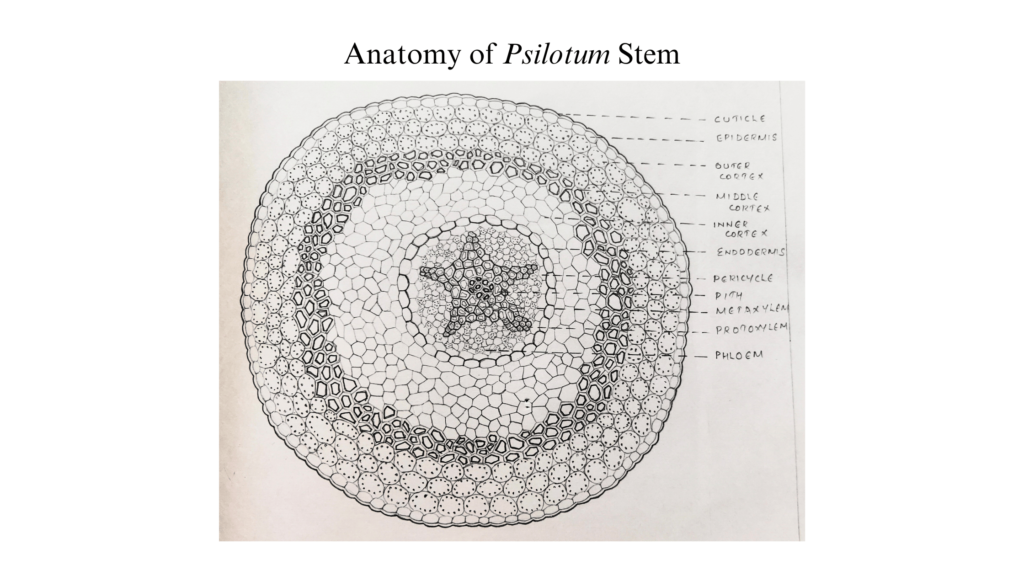
Stem Anatomy
- The cross-section of the Psilotum stem shows a circular shape at the bottom but becomes gradually ribbed towards the upper region.
- In the upper portion, it almost forms a pentagon due to the ribbed structure.
- It has an epidermis made of rectangular cells, with a cuticle layer on the outer tangential walls.
- Sunen stomata are seen on the epidermis.
- The cortex is differentiated into outer, middle and centre regions.
- A few layers of parenchymatous cells with chloroplasts form the outer cortex.
- The stomata are connected to the vertical air spaces in the outer cortex.
- The middle cortex is made of sclerenchymatous cells for support.
- The inner cortex has cells that store starch grains.
- The inner cortex is followed by an endodermis and a pericycle respectively.
- Psilotum shows different types of stele in different parts of the stem.
- The Psilotum stem has protostele at the basal region and siphonostele in the middle and upper portions.
- The protostele shows lobed xylem in patches, with its tips occupied by the protoxylem.
- This exarch xylem is star-shaped and sclerefied in the pith.
- Phloem surrounds the xylem completely.
Leaf Anatomy
- The simple leaf of Psilotum has an epidermis with a thick cuticle.
- Stomata are absent in Psilotum leaves.
- The mesophyll has chlorenchyma cells.
- There are no vascular tissues in the leaves.
Reproduction in Psilotum
Psilotum shows alternation of generations. Each generation, the sporophyte and gametophyte reproduce separately. The sporophyte produces spores and the gametophyte produces gametes that fuse to form the diploid sporophyte.
The spores from the sporophytic generation are produced in a trilobed structure called synangium.
Synagium of Psilotum
Synagium of Psilotum is a part of asexual reproduction. It is a complex and trilobed structure formed in the main axis branches. They appear at the tip and are yellow in color.
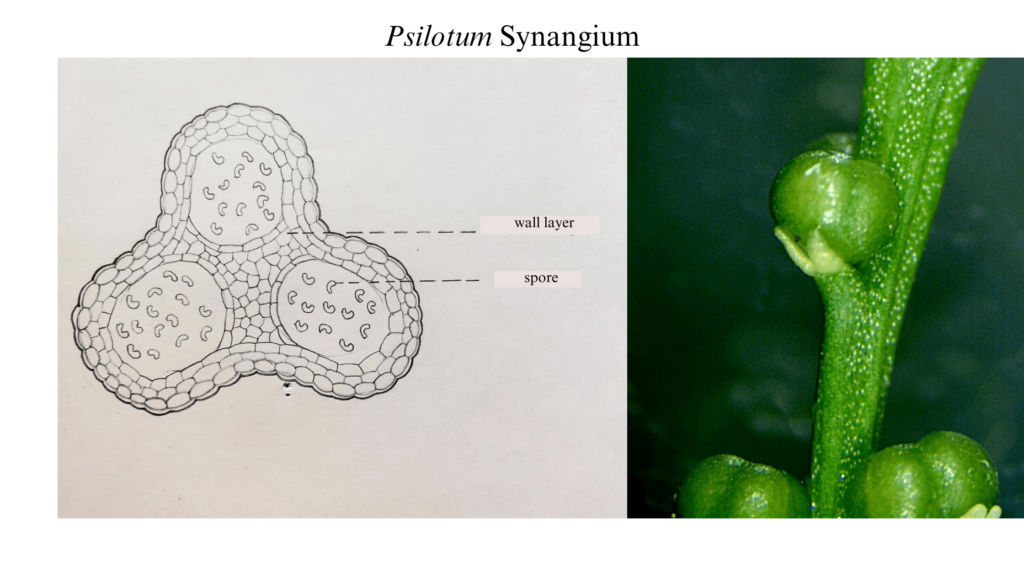
- A synagium is produced by the fusion of three sporangium.
- There are two lateral and one terminal sporangium.
- Each lobe of the synangium is a sporangium that produces numerous spores.
- Each sporangia has an individual wall that separates it from the other two sporangia.
- This wall is 2-3 layered.
- The outermost wall layer functions as the epidermis.
- The innermost layer separates the lobes.
- Each lobe has individual vascular traces.
- Cells inside each sporangia are diploid spore mother cells.
- These spores are haploid.
- Spores disperse and fall on a suitable substrate to grow into a gametophyte.
Sexual reproduction in Psilotum
- The gametophytes live underground until favorable conditions. During this time, it functions as a saprophyte and sometimes in a mycorrhizal association.
- It shows dichotomous branching underground and contains vascular tissues.
- This gametophyte is called a prothallus which produces both egg and sperm cells upon maturity.
- On maturity, the prothallus produces an archegonium and an antheridium to produce the egg and sperm respectively.
Life Cycle of Psilotum
- Psilotum exhibits an alternation of generation between the sporophyte and a gametophyte.
- The plant body is a diploid sporophyte.
- This sporophyte produces haploid spores from the synangium that develop into a gametophyte.
- The gametophyte produced haploid gametes that fuse to form the diploid zygote.
- The zygote develops into the diploid plant body.
References
- Abraham P C. Bryophytes, Pteridophytes, Gymnosperms & Paleobotany. 2000. St. Mary’s Books & Publications.
- https://jagiroadcollegelive.co.in/attendence/classnotes/files/1621079462.pdf
